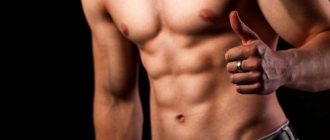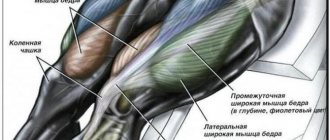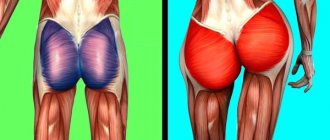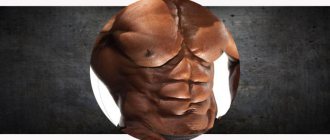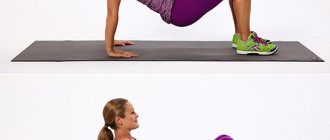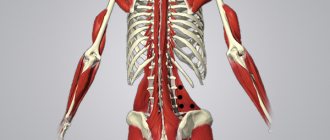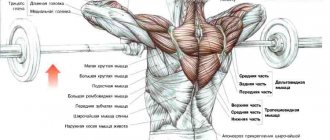Every person has ever heard something so loud that the sound even gave them a headache. Maybe it was a fire alarm, an ambulance siren, or even a crying baby. It doesn’t matter at all where this deafening sound could come from: the most important desire of any person who heard it was to stop it. There is a small muscle in the human ear called the stapedius that helps limit vibrations in the ear when we hear very loud sounds. In addition, it has the status of the smallest and shortest muscle in the human body.
Bruises and sprains
In the first place are bruises and sprains, which can cause pain under the arms.
© shutterstock
Sprained muscles and ligaments in the armpit area are a common cause of pain. She can be weak, tolerant and strong. You just have to carelessly bend over, lift some weighty object, hit something with your shoulder or wave your hand sharply and a traumatic injury will appear.
Often such difficulties are faced by athletes who receive regular physical activity. 20% of people who work as musicians, cashiers, and machinists also complain of frequent muscle strains.
Signs of stretching
The main sign of muscle strain under the arms is a nagging pain that intensifies with movement.
With a weak degree of damage, movements are not constrained, but cause unpleasant discomfort. In moderate sprains, pain under the armpit accompanies every action. Lifting weights is very difficult. But a strong degree will not let you forget about yourself for a minute. Regular piercing pain requires medical diagnosis and treatment.
Treatment options
If a person has pain in the armpits after physical activity, they should stop. Apply ice to the sprained area, it will help get rid of the initial pain. Minor traumatic injuries can be effectively cured with the help of an ointment or gel , which contains anti-inflammatory components. The victim can also take a painkiller tablet to fully rest after the incident.
If a muscle rupture occurs under the armpit, this will immediately become clear, since the pain will be very severe and painful, you need to immediately go to a specialist for an examination. The doctor will resort to secondary methods of treating sprains:
- Physiotherapy;
- Anti-inflammatory medications;
- Injections;
- Therapeutic exercises;
- Rehabilitation period.
The duration of the procedures will depend on the severity of the damage.
You should not delay a visit to a specialist when the muscles under your arms hurt, as the lack of proper diagnosis and treatment can lead to unpleasant consequences.
Chest muscles
Own muscles
The fibers of the intrinsic chest muscles lie in three intersecting directions. This structure strengthens the chest wall.
| Muscle | Start | Attachment | Function |
| External intercostal muscles | Lower edge of the overlying rib | Upper edge of the underlying rib | During contraction, the ribs are raised, increasing the volume of the chest in the anteroposterior and transverse directions. One of the main muscles of inspiration. |
| Muscles that lift the ribs | Transverse processes of the thoracic vertebrae | Angle of nearby edge | During contraction, the ribs are raised, increasing the volume of the chest in the anteroposterior and transverse directions. One of the main muscles of inspiration. |
| Internal intercostal muscles | Upper edge of the underlying rib | Lower edge of the overlying rib | By contracting, the ribs lower and, by reducing the size of the chest, promote exhalation. |
| Innermost intercostal muscles (internal bundles of internal intercostal muscles) | Upper edge of underlying ribs | Lower edge of overlying ribs | By contracting, the ribs lower and, by reducing the size of the chest, promote exhalation. |
| Transverse thoracis muscle | Xiphoid process of the sternum | Inner surface of the cartilages of the II-VI ribs | Lowers the ribs, promotes exhalation. |
| Subcostal muscles | X-XII ribs near their corners (inner surface) | Inner surface of overlying ribs | The ribs drop. |
| Diaphragm (stomach obstruction) | Sternum, ribs, lumbar vertebrae | Forms a tendon center | Main respiratory muscle. As it contracts, its dome lowers and the vertical size of the chest increases; at the same time, the lungs are mechanically stretched and inhalation is carried out. |
| Pectoralis major muscle | Medial half of the clavicle, manubrium and body of the sternum, cartilages of the II-VII ribs, anterior wall of the rectus sheath | Crest of the greater tubercle of the humerus | Brings the shoulder towards the body, lowers the raised shoulder. With fixed upper limbs, it raises the ribs and participates in the act of inhalation. |
Alien muscles
The alien muscles that cover one's own chest muscles are powerfully developed in humans. They move and strengthen the upper limbs on the body.
| Muscle | Start | Attachment | Function |
| Pectoralis major muscle | Sternal part of the clavicle, edge of the sternum, cartilages of the V-VI ribs | Crest of the greater tubercle of the humerus | By contracting, the muscle adducts and pronates the shoulder, pulling it forward. |
| Pectoralis minor muscle | II-V ribs | Coracoid process | When contracting, it pulls the scapula down and forward. |
| Serratus anterior muscle | II-IX ribs | Medial edge of the scapula and its inferior angle | When contracted, the muscle pulls the scapula forward and its lower angle outward, due to which the scapula rotates around the sagittal axis and its lateral angle rises. If the arm is abducted, the muscle, rotating the scapula, raises the arm above the level of the shoulder joint. |
Allergy
Today, many cosmetic products are advertised to help maintain the condition of the skin under the arms. Deodorants and antiperspirants have moisturizing, protecting, regulating and odor-eliminating components that can cause allergic reactions, and therefore pain in the armpits.
© shutterstock
Every person uses such products, because they are an integral part of personal hygiene. They contain various synthetic components, one of which the human body may react poorly to.
An allergy under the arm may appear after the first use . And it is impossible to determine what exactly caused the problem without a doctor’s diagnosis. Since some manufacturers do not write on the label the harmful substances that are included in the composition. And people who buy drugs don’t even pay attention to the expiration date.
There is also a difference between deodorant and antiperspirant. The first eliminates the unpleasant odor of sweat, and the second blocks sweating. Therefore, it is not recommended to use antiperspirant frequently, as allergies may result.
Signs of allergies
The symptoms of allergies are very clear:
- The skin under the arms turns red;
- A rash, itching, peeling appears;
- The person begins to sneeze and cough;
- The nasal mucosa becomes inflamed;
- The eyes begin to water.
Respiratory symptoms appear after using the spray. With frequent use of roll-on deodorant, severe cases may occur: purulent rash, erosion.
Treatment options
To cure an allergy that causes pain in the armpit, you should find out what exactly the side effect is.
If the skin under the armpit hurts, only when using a certain brand of cosmetic product, it is enough to change the deodorant. In circumstances where changing the remedy does not bring positive results, you should seek help from a specialist.
Doctors treat allergies with antihistamines and ointments . The patient must follow the regimen and dosage of the prescribed therapy so that the treatment is productive and without consequences.
Auxiliary elements
The structure of human muscles cannot be considered without auxiliary elements.
Everything from a myocyte to a group of muscles is surrounded by fascia called endo-, peri- and epimysium (from internal to superficial, respectively). This connective tissue limits functional muscle groups from each other, attaches them to bones and skin, supports and protects them. In places where the fascia is damaged, a muscle hernia forms.
The joint capsule is another connective tissue membrane. It surrounds the joint, provides it with nutrition and protection.
Bones are the element without which muscles could not work. The muscles are attached to them and work is done on them. Some of them (sesamoids) are not attached to other bones, but are located in the thickness of the tendons, preventing them from moving in the wrong planes (for example, the kneecap).
Lymphadenitis
The lymph nodes under the armpit tend to become inflamed during infectious lesions, causing excruciating pain and a lot of inconvenience. This disease is called lymphadenitis. It is a common ailment for which people turn to doctors.
© shutterstock
Lymph nodes play an important role in protecting the human body from all kinds of infections, including viruses, bacteria, toxins and much more.
Lymphadenitis can be specific and nonspecific . The first manifests itself due to such diseases:
- Tuberculosis;
- Syphilis;
- Actinomycosis;
- Plague;
- Tularemia.
The second is formed due to staphylococcal, streptococcal and viral infections.
Signs of lymphadenitis
If the lymph node under the arm is inflamed and hurts, the skin around it becomes reddish, then these are the first signs of acute lymphadenitis.
In addition to armpit pain, the patient exhibits the following symptoms::
- Heat;
- Shiver;
- Fatigue;
- Migraine;
- General malaise.
When the lymph nodes under the arm are excited by viral infections, microorganisms will begin to move throughout the body, which will lead to general poisoning of the body.
Treatment options
When the lymph nodes under the arms hurt, self-treatment is strictly prohibited! If pain begins to occur in the armpit area, it is recommended to immediately go to the doctor. Since the root causes and consequences of enlarged lymph nodes under the arm can be of different characters.
Acute nonspecific lymphadenitis is treated conservatively. The doctor prescribes antibiotics, drugs that strengthen the immune system, painkillers and UHF therapy.
When a patient is diagnosed with purulent lymphadenitis, surgical intervention is prescribed in order to avoid the spread of infections throughout the body. After which medications are prescribed, consisting of tablets and ointments.
Forecast
As a result of long research, scientists have developed a special IPI (international prognostic index), showing the survival of patients and their further prognosis.
This indicator is influenced by the following factors:
- Patient's age.
- Serum LDH level (elevated or normal).
- General characteristics of the patient's condition (according to the WHO scale).
- The degree of cancer development.
- The number of inflamed lymph nodes.
After the diagnosis, for each indicator separately, the doctor makes a general conclusion and prognosis. By noticing an inflamed lymph node in time and undertaking high-quality comprehensive treatment, you can eliminate the problem without consequences or complications.
Atheroma
In cases where a lump appears under the armpit and it hurts, this signals the formation of atheroma - a benign or malignant subcutaneous compaction. The sebaceous pituitary glands gather into a “tangle” after a disruption of the metabolic process and clogging of the gland ducts, which can occur as a result of :
- Hormonal imbalances;
- Hyperhidrosis;
- Lack of personal hygiene;
- Depilation;
- Impacts and injuries;
- Use of low-quality cosmetics.
© shutterstock
According to statistics established by doctors, the majority of people who seek help due to unbearable pain in the armpit experience the transformation of atheroma into an abscess.
If proper treatment is not carried out, the purulent tumor will spontaneously open over time, bringing relief to the person. But the pain under the armpit will disappear for a short period of time, because the disease will continue to manifest itself until complete medical treatment occurs.
Signs of atheroma
The signs of atheroma are not very different from other symptoms of pain in the armpits:
- High temperature and blood pressure;
- Intoxication of the body;
- Hyperemia;
- Throbbing pain under the armpit.
Treatment options
If a lump under your arm hurts, do not put off going to the doctor. The specialist will conduct an examination and prescribe the necessary therapy. If you wait for complications of atheroma, treatment can become painful and unsafe.
To remove atheroma, the doctor selects an individual method for each patient. The lump can be removed using :
- Laser surgery;
- Radio wave elimination;
- Surgical intervention.
The laser removes barely noticeable formations that cause pain in the left or right armpit. An effective and safe method does not leave scars or marks on the skin.
Using radio waves, atheroma cells are destroyed. After such therapy, a small depression remains under the armpit, onto which a sterile bandage is applied.
Surgical intervention is a radical treatment method that helps remove purulent atheroma of any size. After removing the tumor, the wound is treated with an antiseptic drug and only then the required number of stitches is applied. With this method of treatment, an infection can enter the body, plus the rehabilitation period will last much longer. Therefore, it is not recommended to delay visiting the doctor until the last minute.
In any case, when there is pain inside the armpit, the body gives signs of alarm that should not go unnoticed.
Muscles of the leg and foot
In sports anatomy, it is customary to consider the foot and lower leg as a single “apparatus”. Because the muscles responsible for the movement of the feet begin in the lower leg and move to the feet.
For example, the flexor digitorum longus muscles are deep muscles of the calf that attach to the toes.
The tibialis anterior muscle runs along the tibia and passes into the tendon of the foot. It is responsible for extension and supination of the foot.
And the triceps surae muscle passes into the Achilles tendon and is involved in flexing the foot at the ankle joint.
That is, the muscles of the lower leg, rather than the foot, are more responsible for our stability.
Hidradenitis
Hidradenitis is an inflammatory formation in the ducts of the apocrine glands. Acute, suppurating inflammation and abscess form not only under the armpit, but also on the scrotum, anus, female labia and under the breasts.
© shutterstock
Young children and older people are not susceptible to this disease. Unfortunately, women aged 16 to 60 years are more vulnerable, since the disease begins to produce secretions from puberty and ends at menopause.
The main cause of hidradenitis is a humid environment resulting from excessive sweating . Biological moisture is an ideal environment for the accumulation of viruses, fungi and bacterial infections. Which leads to clogging of the sweat centers, and as a result, inflammation appears.
Hidradenitis, accompanied by pain in the armpits, awakens due to the following factors:
- Weakness of the immune system;
- Hormonal imbalances;
- Dermatological skin defects;
- Impaired functioning of the sweat glands;
- Excess weight;
- Problems with the nervous system;
- Regular fasting;
- Numerous exposures;
- Long-term hormonal medications;
- Inaccurate hair removal;
- Gastrointestinal pathologies;
Signs of hidradenitis
The first sign of inflammation of the disease is if pain in the armpit area is accompanied by a painful small nodule, which after a day reaches a diameter of up to 20 mm and becomes purple in color.
New formations gradually form next to the lesion, merging into one large lump filled with pus. The swelling increases, the pain under the armpit becomes unbearable, the person tries not to move his arm.
Among the main symptoms of hidradenitis are::
- A lump that does not stop growing;
- Severe swelling;
- Redness of the skin;
- High body temperature;
- Itching;
- Regular pain.
Treatment options
Depending on the degree of inflammation, the disease is treated with conservative or radical methods. Conservative includes taking medications, folk remedies and physical therapy. The radical method is surgical intervention, which will help get rid of the inflamed node and will require postoperative procedures.
It is worth knowing that a disease such as hidradenitis does not go away on its own. If a person decides to squeeze the pus out of the nodules himself, the infection will begin to spread , which will lead to complications that cannot be cured without proper therapy. Therefore, at the first feeling of pain in the armpits, it is advisable to visit the hospital.
Back muscles
The back muscles also traditionally include the muscles lying on the neck behind the spine.
Proprietary muscles of ventral origin
| Muscle | Start | Attachment | Function |
| Serratus posterior superior muscle | From the lower part of the nuchal ligament, two (one) lower cervical and two upper thoracic vertebrae | II-V ribs | Raises the II-V ribs, expanding the chest during breathing. |
| Serratus posterior inferior muscle | From the spinous processes of 2 (1) lower thoracic vertebrae and 2 (3) upper lumbar vertebrae | IX-XII ribs | Lowers the IX-XII ribs, narrowing the chest during breathing. |
Proprietary muscles of dorsal origin (deep muscles of the back)
I tract
| Muscle | Start | Attachment | Function |
| Splenius capitis muscle | From the nuchal ligament, spinous processes of the 3 lower cervical and 3 upper thoracic vertebrae | Occipital bone | Turn, tilt the head to the side, with bilateral contraction - extension of the cervical spine. |
| Splenius neck muscle | From the spinous processes of 3-5 thoracic vertebrae | Posterior tubercles of the transverse processes of the 2-3 upper cervical vertebrae | With a bilateral contraction, it pulls the head and neck back; with a unilateral contraction, it pulls in its direction, turning the head and neck. |
II tract
| Muscle | Start | Attachment | Function |
| Erector spinae muscle | Spinous processes of the lumbar and lower thoracic vertebrae, sacrum, iliac crest | Angles of ribs, transverse processes of VI-VII cervical vertebrae | Keeps the body in an upright position, straightens the spine. |
| Iliocostal muscle | Spinous processes of the lumbar and lower thoracic vertebrae, sacrum, iliac crest | Transverse processes of the thoracic and cervical vertebrae, angles of the II-XII ribs, temporal bone | Together with the rest of the erector spinae muscle, it extends the spine; with unilateral contraction, it tilts the spine in its direction and lowers the ribs. The lower bundles of this muscle, pulling and strengthening the ribs, create support for the diaphragm. |
| Longissimus muscle | Spinous processes of the lumbar and lower thoracic vertebrae, sacrum, iliac crest | Transverse processes of the thoracic and cervical vertebrae, angles of the II-XII ribs, temporal bone | Together with the rest of the erector spinae muscle, it extends the spine; with unilateral contraction, it tilts the spine in its direction and lowers the ribs. The lower bundles of this muscle, pulling and strengthening the ribs, create support for the diaphragm. |
| Spinalis muscle | Spinous processes of the lumbar and lower thoracic vertebrae, sacrum, iliac crest | Spinous processes of the thoracic and cervical vertebrae, occipital bone | Extends the spine. |
III tract
| Muscle | Start | Attachment | Function |
| Transverse spinalis dorsi muscle | Transverse processes of vertebrae | Spinous processes of overlying vertebrae | With bilateral contraction, it extends the corresponding part of the spine; if it is unilateral, it tilts the spine in its direction. |
IV tract
| Muscle | Start | Attachment | Function |
| Intertransverse muscles | Transverse processes of vertebrae | Transverse processes of overlying vertebrae | Tilt the spine in your direction. |
| Interspinous muscles | Spinous processes of vertebrae | Spinous processes of overlying vertebrae | Extend the spine. |
| Short occipitovertebral muscles | Extend and rotate the head |
Alien muscles
Surface layer
| Muscle | Start | Attachment | Function |
| Trapezius muscle | Lower part of the occipital bone, spinous processes of the VII cervical and all thoracic vertebrae | Acromial end of clavicle, acromion, spine of scapula | Rotates, leads to the spine, raises and lowers the scapula; turns his head. |
| Latissimus dorsi muscle | Spinous processes of the six lower thoracic and all lumbar vertebrae, sacrum, iliac crest, ribs IX-VII | Crest of the lesser tubercle of the humerus (proximal) | Brings the shoulder to the body, rotates it inward. |
Second layer
| Muscle | Start | Attachment | Function |
| Rhomboid muscle | Spinous processes of the VII cervical and I-V thoracic vertebrae | Medial edge of the scapula | Brings the scapula closer to the spine while simultaneously moving it upward. |
| Levator scapulae muscle | Transverse processes of the four upper cervical vertebrae | Upper angle of the scapula | Raises the scapula, simultaneously bringing it closer to the spine; with a strengthened scapula, tilts the cervical part of the spine backwards and towards itself. |
Mastopathy
Many women are interested in the question of whether pain in the armpit can occur due to disorders of the mammary glands. Yes maybe. And this disease is called mastopathy. This pathology manifests itself only in females, because it is associated with transformation in the exocrine glands. Mastopathy can be caused by :
- Increased estrogen levels;
- Violation of ovarian activity;
- Complete absence of childbirth;
- Abortion;
- Early onset of menstruation and puberty;
- Chest injuries;
- Wearing a tight bra;
- Bad habits;
- Regular stress;
- Inherited genes;
- Gynecological ailments;
- Excess weight and many other factors.
© shutterstock
Signs of mastopathy
Before the menstrual cycle, a girl experiences pain of varying degrees in her chest, which is transmitted to the armpits.
In the middle of the cycle, the bust becomes denser, heavy, hypersensitive and increases in size.
Then discharge from the nipples appears when the bust is squeezed. The liquid can be colorless, white, light green, brown, or bloody in color.
Not so popular causes of armpit pain
When it hurts on the left side of the armpit, without causing inflammation, you need to check the vascular system of the heart. Pain in the left armpit is caused by the following ailments :
- Coronary heart disease;
- "Pectoris angina";
- Myocardial infarction.
If the right armpit hurts, the source may be all of the above diseases, not counting myocardial infarction. But when the inflammatory course is not observed, osteochondrosis or neuralgia can be considered the basis.
Less popular reasons also include:
- Folliculitis;
- Boils;
- Carbuncles;
- Pain in papilloma under the armpit;
- Neoplasms;
- Nervous system disorders;
- Pyoderma.
Summarizing
If the muscles under the arms ache or if compacted tumors in the same place bother you, it is better not to wait for complications, but to seek recommendations from a clinic.
Pain in the armpits does not disappear on its own. They ask for appropriate treatment, which is prescribed after a full examination that helps determine the origin of the disease.
It is worth remembering that an exacerbation will contribute to surgical intervention, which can be avoided by consulting a doctor in case of initial pain in the armpits.
Gastrocnemius
Calf muscle
In terms of its ability to stretch, the calf muscle can be called the strongest in the human body. When stretched, this muscle can support more than 130 kilograms. When walking, they take the entire load upon themselves. If you stand on tiptoes or run, the load on the muscles increases several times. Another task of this muscle is balance. When a person stands, the calf muscles prevent him from falling down and folding in half. The hips and quadriceps also deserve attention, since they are the ones that support the entire human skeleton throughout his life when walking, running or other sports.

